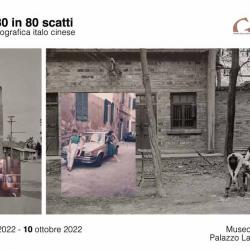
Friday, Sept. 23 at 11 a.m. opens the exhibition "The 80s in 80 Shots" a collection of 20 photographic prints made by artist and sinologist Andrea Cavazzuti, as well as 60 digitized photographs (slides) traced from the albums of families who emigrated from China to Italy in the 1980s.
The brainchild of the EOE (EstOvestEst) association, the exhibition is sponsored by the City of Pisa and the Confucius Institute of Pisa, EOE's main partner, with support also from IMAGO and ACSI.
On the occasion of the exhibition, a discussion is scheduled for Friday, Sept. 30, to tell the story of China in those years and the way the first Chinese families, their integration process and first relationships were beginning to appear in the Italian context. In addition to artist Andrea Cavazzuti, the meeting will be attended by Barbara Pasquale, documentary filmmaker and video editor; Carlo Laurenti, writer and translator; and Zhi An, professor and writer connected directly from China via streaming.
Speakers will include:
Paolo Pesciatini - Councillor for Tourism and Commerce of the Municipality of Pisa
Alessandro Tosi - Director of the Museum of Graphics
Wang Yunlin - Director of the Confucius Institute of Pisa
Elisa Debernardi - President of the EOE Association
Cristian Biasci - Vice president of the EOE Association
About the exhibition
Andrea Cavazzuti's refined research, which is presented with black-and-white prints of photographs taken in those years, contrasts with the photos offered on video, taken from family albums, color photos that retain the flavor of the common prints that each of us keeps among our memories, and constitute food for thought on a period of our recent history that, when viewed with very different gazes, underscores a distance that today seems almost forgotten. This is how photographer Andrea Cavazzuti explains his relationship with China in an interview by Olivo Barbieri "...trained as I was to look beyond stereotypes even at home, I photographed a China unseen and, what is worse, not even imagined, therefore invisible. Things already seen satisfy, comfort, have to do with memory, while the unseen is dry, unfriendly, refractory, sometimes obnoxious. China presented itself to me as an extraordinary bazaar of objects, scenes, and behaviors that are not standardized among our cultural clichés. It was irresistible to me: the objects in view, the total lack of privacy, the human activities staged on an always open stage, a photographer's paradise." He concludes, "It is not possible to imagine what China will be tomorrow without considering what it was until yesterday. It is the last frontier of expansion of global civilization as we have known it until now. It is the last and final confrontation of civilization. After China, we will be at the crossroads. I delude myself and hope, with this life choice of mine, that I have at least given myself and my children the chance, once we reach the crossroads, to know how to read the road signs."
Biographical Notes on Andrea Cavazzuti
Andrea Cavazzuti (Milan, 1959) is an artist, photographer, video and film maker and sinologist. He graduated in Chinese language and literature from Ca' Foscari in Venice. In the early 1980s he went to China to Nanjing in 1981 and then to Shanghai in 1982 to study for two years at Fudan University, an experience that established his unbreakable bond with China. He began photographing in the 1970s. In the 1990s he turned to video and film. His work deals with different aspects of art and society. He has made and participated in numerous productions, both television and film, later distributed by RAI, ARTÈ, SRF, ABC and Sky TV, as well as screened in cinemas and international cultural institutions. His work has been exhibited in Museums such as, Triennale di Milano, Italy; Guangdong Museum of Art, Guangzhou, China; Museo Marco, Vigo, Spain; Working People's Cultural Palace, Beijing and Changjiang Museum, Taiyuan, China; MAXXI, Rome, Italy; Carnegie Hall, New York, United States; and Museo Ferroviario di Pietrarsa, Naples, Italy.
The exhibition will be on view from Friday, Sept. 23 to Sunday, Oct. 9.